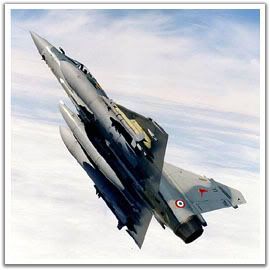Russia is fielding a new generation of missiles, France just fielded the first nuclear warhead to be qualified without testing (on the ASMP-A air-launched missile), and China maintains its policy of concealing the type, number and status of nuclear programs.
 The Mirage 2000N (Nucleaire) is the nuclear strike component of France's Force Aerienne Strategique (FAS). It is the seventh-generation of Mirage combat aircraft. The Mirage 2000N is a two-seater, single-engine, delta-wing, low altitude penetration variant. The first batch became operational in 1988, with production ending in 1993. Some of the earlier models have been fitted for a dual-use conventional ground-attack capability. To carry out their mission, they are fitted with terrain-following radar, two inertial guidance platforms, two Magic self-defense missiles, and a jamming suite.
The Mirage 2000N (Nucleaire) is the nuclear strike component of France's Force Aerienne Strategique (FAS). It is the seventh-generation of Mirage combat aircraft. The Mirage 2000N is a two-seater, single-engine, delta-wing, low altitude penetration variant. The first batch became operational in 1988, with production ending in 1993. Some of the earlier models have been fitted for a dual-use conventional ground-attack capability. To carry out their mission, they are fitted with terrain-following radar, two inertial guidance platforms, two Magic self-defense missiles, and a jamming suite. A new British government has spent a great deal of recent investment in weapons development.
Then there are the “new nuclear” countries. North Korea conducted its second nuclear test in May, and is persisting with the Taepodong-2 ICBM despite the failure of a launch in April. India continues to develop a range of nuclear missiles.
Iran’s plans cause the deepest concern, following the discovery in September of the undisclosed Fordow enrichment plant near Qom. Isreal’s military intelligence chief, Maj. Gen. Amos Yadin, stated in comments to the Knesset that (contrary to the assertions of Iranian President Mahmoud Ahmadinejad) Israel’s assessment is that the facility has no visible civilian purpose. The underground plant appears too small for a civilian program, but is large enough for military activities, with space for 3,000 advanced centrifuges. Qom could be the tip of a “nuclear iceberg”, sources close to Israeli intelligence warn. The secret underground facility at Natanz, revealed by Iranian dissidents in 2002, has grown to house 9,000 centrifuges and seems to have produced enough low-enriched uranium for two simple warheads.
Isreali analysts are also concerned about the reported discovery by international monitors of large quantities of heavy water at the Isfahan nuclear technology research center. Heavy water can be used to produce tritium, which intensifies the explosive force of warheads.
No comments:
Post a Comment